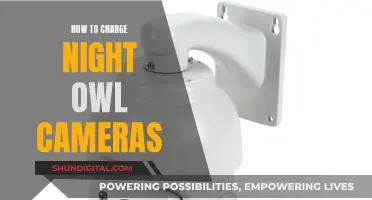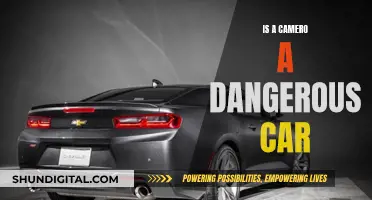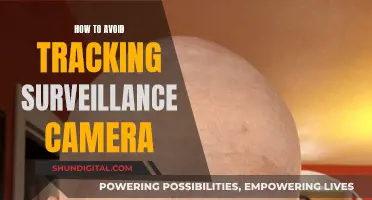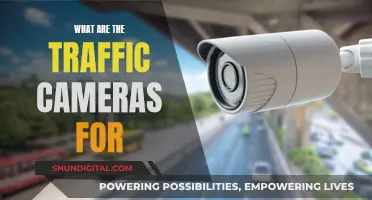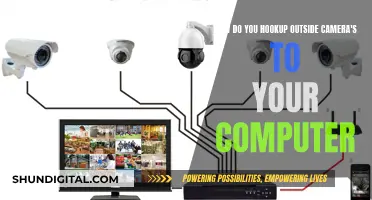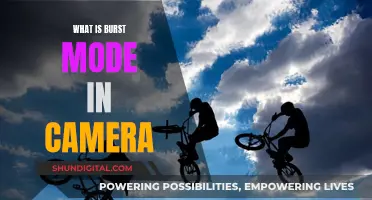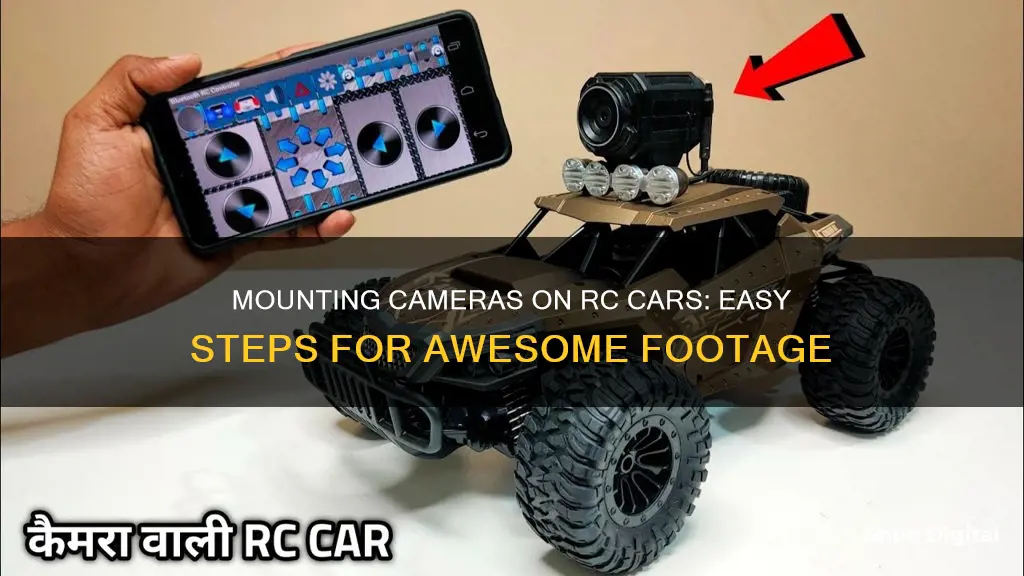
Attaching a camera to an RC car is a great way to capture unique footage and gain a new perspective on the vehicle's movement. It can be a fun and exciting way to enhance your RC car experience, whether you're using it for personal enjoyment or sharing your footage online. With the right equipment and some basic knowledge, you can easily set up a camera on your RC car to record your adventures. In this article, we will discuss the steps and considerations for attaching a camera to your RC car, ensuring that you capture smooth and stable footage while having fun with your setup.
| Characteristics | Values |
|---|---|
| Camera Types | Action Cameras, Mini Cameras, Smartphone Cameras |
| Mount Types | Suction Mount, Clamp Mount, Adhesive Mount |
| Additional Measures | Zip Ties, Duct Tape, Counterweights |
| Camera Brands | GoPro, DJI, Insta360 |
| Mount Brands | Fat Gecko, GoPro Roll Bar |
| RC Car Activities | Indoor Racing, Outdoor Exploration |
What You'll Learn

Choosing the right camera
- Size: Ensure the camera is not too big for your RC car model, as a bulky camera may slow down your car and increase the risk of collisions. However, don't go too small, as you may compromise feedback quality and range.
- Power: Most FPV RC cameras use very little power, typically between 0.25w and 2w. Check your RC car's battery specifications to ensure it can handle the camera's power requirements.
- Video Feedback Quality: If you're looking for an FPV (First-Person View) camera, opt for a resolution of at least 700p HD. Some cameras are measured in TVL (TV-Lines), so aim for a minimum of 700-1000TVL if using this format.
- Mounting: Consider how the camera will be mounted to your RC car. Some cameras come with screw attachments, while others require tape or glue. Choose a mounting option that suits your RC car's chassis type and your personal preference for sturdiness.
- Price: Stay within your budget, especially if you're a beginner. Remember that you'll also need to purchase feedback equipment like a display or goggles.
Some popular camera options for RC cars include:
- Action cameras: Small, durable cameras commonly used for sports and outdoor activities. GoPro and DJI Osmo Action are popular choices.
- Mini cameras: Specifically designed for RC cars, these cameras are typically cheaper and easier to mount than action cameras.
- Smartphone cameras: If you have a smartphone with a good camera, you can mount it to your RC car with a suitable mount.
When selecting a camera, consider your specific needs, such as the type of footage you want to capture, your budget, and the mounting options available for your RC car.
Traffic Camera Tickets in Denver: Do You Have to Pay?
You may want to see also

Selecting the mount
When selecting a mount for your RC car, there are several factors to consider, including the type of camera you have, the activities you plan to do, and the surface you'll be attaching it to. Here are some tips to help you choose the right mount:
- Consider the size and weight of your camera. Heavier cameras may require a more sturdy and secure mount to prevent them from falling off during use.
- Think about the surface you'll be attaching the mount to. Smooth surfaces are ideal for suction cup mounts, while adhesive mounts can be used on most surfaces, including the car's body or wheels.
- Decide whether you want a permanent or removable mount. Adhesive mounts provide a secure grip but are more permanent, whereas suction cup and clamp mounts are easier to remove.
- Choose a mount that is durable and can withstand high speeds, bumpy terrain, and sudden impacts.
- If you plan to capture footage from different angles, consider a mount with a rotating arm to adjust the camera's angle and orientation.
- Ensure the mount is compatible with your camera model. Not all GoPro mounts, for example, fit all GoPro cameras, so check the compatibility before making a purchase.
- Consider using extra measures, such as zip ties or duct tape, to ensure that the camera and mount stay securely in place.
- Balance the weight of the camera and mount to avoid placing too much weight on one side, which can cause the mount to become unbalanced and fall off.
- Suction Cup Mount: This type of mount uses suction cups to secure the camera to smooth surfaces, providing a stable shot.
- Adhesive Mount: This type uses a strong adhesive to attach the camera directly to the car's body, wheels, or other surfaces. It provides a secure grip but is more challenging to remove.
- Clamp Mount: This mount securely fastens the camera to various parts of the car's chassis, offering flexibility in positioning.
When selecting a mount, it is essential to consider your specific needs and preferences. Some mounts may be more versatile, while others may be designed for a specific type of camera or vehicle. It is also crucial to ensure that the mount is securely attached to the RC car to prevent accidents and damage to your equipment.
Mastering Focus Pulls with Your Mirrorless Camera
You may want to see also

Securing the camera
- Tighten the mount: Ensure that the camera mount is securely tightened to the RC car. This is the first line of defence against the camera falling off or moving during use.
- Use zip ties: Zip ties are a versatile and effective way to secure the camera to the RC car. They can be used to attach the camera to various parts of the car's chassis.
- Tape it up: Strong tape, such as Gorilla Tape, can be used to secure the camera to a mount or directly to the RC car. This method is simple and effective, especially when combined with other measures.
- Counter the weight: If your camera setup is heavy, consider counterweights to balance the setup and prevent it from falling off during manoeuvres. You can purchase counterweights or make your own using weights or heavy objects.
- Minimise vibrations: Vibrations can cause the camera mount to loosen over time. Use padding or earplugs to minimise vibrations and reduce the need for frequent tightening.
- Extra measures: For added security, consider using duct tape or additional zip ties to ensure the camera stays in place, even during high-speed manoeuvres.
By following these tips and methods, you can ensure that your camera is securely attached to your RC car, allowing you to capture smooth and stable footage without worrying about the camera's stability.
Dating Your Camera: Year of Manufacture Matters
You may want to see also

Balancing the camera
- Position the camera correctly: Ensure that the camera is positioned in the centre of the mount and facing the right direction.
- Adjust the weight distribution: If the camera is too heavy on one side, it can cause the mount to become unbalanced and fall off. Adjust the weight to achieve a more balanced setup.
- Use counterweights: If you're struggling to balance your camera, try using counterweights. You can buy these online or make them yourself using weights or other heavy objects.
- Mount your camera on a gimbal or tripod: This will help you balance the camera by allowing you to adjust the sliding plate forward or backward.
- Check the balance with a spirit level: Use a spirit level to check if the camera is balanced on all axes.
- Adjust the motor tension: Adjust the tension of the motor to prevent shaking or vibration.
It may take some trial and error to get the balance right, so be patient and keep adjusting until you achieve smooth and stable footage.
Charging the iForce Camera: A Step-by-Step Guide
You may want to see also

Testing the setup
Check Camera Positioning and Direction:
First, confirm that the camera is positioned correctly and securely in the centre of the mount. Ensure it is facing the right direction, capturing the desired field of view.
Test Footage Quality:
Check that the camera is recording properly and providing stable, clear footage. Ensure the image is not blurry, and the camera isn't experiencing excessive vibration or shaking.
Inspect Mount Security:
Verify that the mount holding the camera is securely fastened to the RC car. Give it a gentle tug to ensure it won't come loose during operation. If needed, tighten the mount and consider using zip ties or duct tape for added security.
Examine Wiring and Connections:
Check that wires or connectors aren't interfering with the camera's movement or the car's overall function. Ensure all cables are neatly tucked away and won't snag on anything during operation.
Evaluate RC Car Performance:
Test the RC car's overall performance with the camera attached. Ensure the weight and positioning of the camera aren't affecting the car's speed, balance, or handling. Confirm that the car is in good working condition and responds as expected to your controls.
Adjust as Needed:
If you encounter any issues during testing, take the time to troubleshoot and make adjustments. This may involve re-positioning the camera, tightening connections, or adding counterweights to improve stability.
Seek Online Resources:
If you need further assistance, there are plenty of online resources available. Check out forums like RC Groups, YouTube tutorials, and manufacturer websites for specific tips and tricks related to your camera and RC car setup.
By following these testing steps, you can ensure that your camera is properly configured and secured, providing you with smooth and captivating footage from your RC car adventures.
Street Camera Tickets: How Long Before They Arrive?
You may want to see also
Frequently asked questions
There are several options to choose from, including action cameras, mini cameras, and smartphone cameras. Action cameras are small, durable, and ideal for capturing high-quality footage, while mini cameras are specifically designed for RC cars and are cheaper and easier to mount. If you have a smartphone with a good camera, you can also use that with a suitable mount.
There are several mounting options available, including suction mounts, clamp mounts, and adhesive mounts. Suction mounts use suction cups to secure the camera to the car, while clamp mounts allow you to attach the camera to various parts of the chassis. Adhesive mounts stick directly to the body or chassis and are commonly used for mini cameras.
You can use strong tape, such as Gorilla tape, to secure the camera to the mount. Additionally, consider using zip ties or duct tape to ensure that the camera and mount stay in place.
Ensure that the camera is positioned in the centre of the mount and facing the correct direction. Adjust the weight distribution to achieve a balanced setup, and consider using counterweights if needed.
Choose a camera and transmitter that fit the size and weight of your RC car. Install them onto the car and secure them with zip ties, double-sided tape, or screws. Attach a video receiver to your FPV goggles or monitor, and tune the frequency of the video transmitter to match the receiver.


